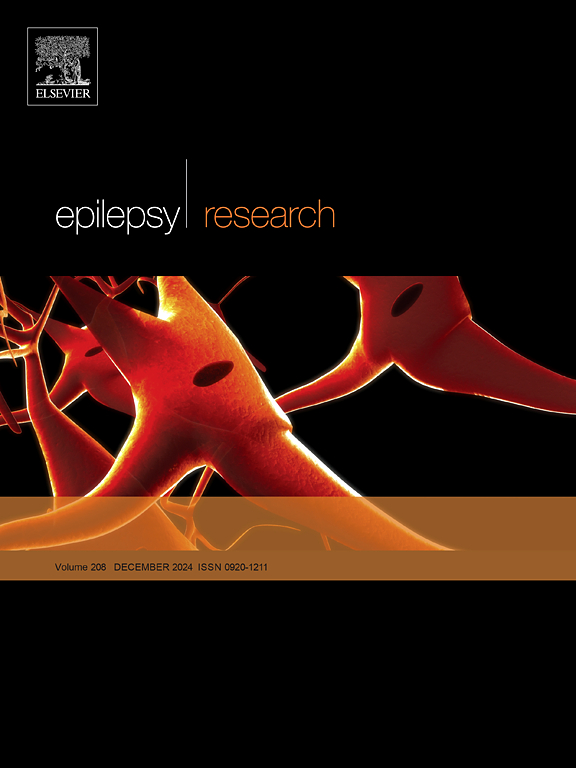癫痫发作视频记录在诊断转诊的耐药性癫痫中的作用:循序渐进法
IF 2
4区 医学
Q3 CLINICAL NEUROLOGY
引用次数: 0
摘要
背景:患者录制的视频为诊断癫痫和心因性非癫痫发作(PNES)提供了一种实用的替代方法,但其在一系列临床问题中的诊断价值仍未得到充分探讨。目的评估患者记录的癫痫视频在区分癫痫与PNES、癫痫类型分类、癫痫病灶定位和偏侧定位方面的诊断价值,以及它们对医生信心和判据可靠性的影响。方法在这项前瞻性两期研究中,筛选了40例提交耐药癫痫评估的患者,其中30例符合纳入标准。诊断由一名神经科医生做出,并由一名独立的神经科医生通过临床资料、脑电图、神经影像学和患者录像进行确认。三位神经科医生独立审查了四个诊断步骤的病例:(1)癫痫vs. PNES,(2)局灶性癫痫vs.全身性癫痫,(3)癫痫定位:颞部vs.颞外,(4)癫痫侧发:右侧vs.左侧。分析了视频整合前后的诊断准确性、医师信心和互译器可靠性。结果步骤1和步骤2的诊断准确率分别为91.67-95 %和95.93-100 %。对视频进行复核后,步骤3和步骤4的准确率较好,分别达到83.87 %和81.48 %。视频显著提高了医生对所有步骤的信心。步骤1和步骤2的判读信度分别提高了0.67和1.00。癫痫定位和侧位的诊断略有下降,同时准确性也有所提高,这反映了医生对正确诊断的不一致改变的趋势。结论第1、2步对癫痫的诊断准确率较高,第3、4步对癫痫的诊断准确率较高。它们与v-EEG和其他诊断方式(如神经成像和侵入性技术)的集成,可以通过提供互补的符号学信息来增强诊断工作流程。进一步的研究需要更大的队列来证实这些发现并优化其在临床实践中的应用。本文章由计算机程序翻译,如有差异,请以英文原文为准。
The role of seizure video recordings in the diagnosis of referred drug-resistant epilepsy: A stepwise approach
Background
Patient-recorded videos offer a practical alternative for diagnosing epilepsy and psychogenic nonepileptic seizures (PNES), yet their diagnostic value across sequential clinical questions remains underexplored.
Objective
To assess the diagnostic utility of patient-recorded seizure videos in distinguishing epilepsy from PNES, classifying seizure types, and localizing and lateralizing epileptic foci, as well as their impact on physician confidence and interrater reliability.
Methods
In this prospective two-phase study, 40 patients referred for drug-resistant epilepsy evaluation were screened, 30 of whom met the inclusion criteria. Diagnoses were made by one neurologist and confirmed by an independent neurologist via clinical data, electroencephalography, neuroimaging, and patient-recorded videos. Three neurologists independently reviewed cases across four diagnostic steps: (1) epilepsy vs. PNES, (2) focal vs. generalized epilepsy, (3) seizure localization: temporal vs. extratemporal, and (4) seizure lateralization: right vs. left. Diagnostic accuracy, physician confidence, and interrater reliability were analyzed before and after video integration.
Results
Diagnostic accuracy achieved excellent results before and after watching videos in Step 1 (91.67–95 %) and Step 2 (95.93–100 %). After the videos were reviewed, the accuracies in Steps 3 and 4 were good, reaching 83.87 % and 81.48 %, respectively. Videos significantly increased physician confidence across all steps. Interrater reliability improved for Steps 1 and 2–0.67 and 1.00, respectively. Those of seizure localization and lateralization slightly decreased, accompanied by increased accuracy, reflecting a trend toward inconsistent alterations to correct diagnoses among physicians.
Conclusion
The accuracy of epilepsy diagnosis in steps 1 and 2 is excellent, and that in steps 3 and 4 is good. Their integration with v-EEG and other diagnostic modalities, such as neuroimaging and invasive techniques, can enhance diagnostic workflows by providing complementary semiological information. Further studies with larger cohorts are warranted to confirm these findings and optimize their application in clinical practice.
求助全文
通过发布文献求助,成功后即可免费获取论文全文。
去求助
来源期刊

Epilepsy Research
医学-临床神经学
CiteScore
0.10
自引率
4.50%
发文量
143
审稿时长
62 days
期刊介绍:
Epilepsy Research provides for publication of high quality articles in both basic and clinical epilepsy research, with a special emphasis on translational research that ultimately relates to epilepsy as a human condition. The journal is intended to provide a forum for reporting the best and most rigorous epilepsy research from all disciplines ranging from biophysics and molecular biology to epidemiological and psychosocial research. As such the journal will publish original papers relevant to epilepsy from any scientific discipline and also studies of a multidisciplinary nature. Clinical and experimental research papers adopting fresh conceptual approaches to the study of epilepsy and its treatment are encouraged. The overriding criteria for publication are novelty, significant clinical or experimental relevance, and interest to a multidisciplinary audience in the broad arena of epilepsy. Review articles focused on any topic of epilepsy research will also be considered, but only if they present an exceptionally clear synthesis of current knowledge and future directions of a research area, based on a critical assessment of the available data or on hypotheses that are likely to stimulate more critical thinking and further advances in an area of epilepsy research.
 求助内容:
求助内容: 应助结果提醒方式:
应助结果提醒方式:


